Photographs: Parth Sanyal/Reuters
The issue of acquiring farmland for industry is threatening to jolt West Bengal's Left Front, the world's longest-running democratically elected Communist government, says Sumit Bhattacharya
A confidential digital map shows exactly how many land owners had taken the compensation, how many had taken partial compensation, and how many had refused to part with their land for the botched Tata Nano plant in Singur, West Bengal.
The map -- based on Global Positioning System readings and land-ownership records -- colour-codes the three categories. You would be hard-pressed to find the greys, the colour assigned for land owners who refused to part with their land for the factory that would have produced the world's cheapest car. It shows that most of the landowners on that roughly 1,000-acre plot had already taken the compensation before the issue snowballed.
"This is no peasant issue," says Gautam Deb, West Bengal's housing and public health minister, "85 per cent of the farmers were ready (to sell)... In America also you will find that 10 per cent are not agreeable (to sell their land for development projects). The issue was how to deal with (Trinamool Congress chief) Mamata (Banerjee). She appears to be a very hard nut. She created the problem."
Others like veteran political analyst and retired political science professor Amiya K Chaudhuri point out that absentee landholders -- not farmers -- took the compensation in Singur.
...
'Farmers realised their livelihood was at stake. So they turned against the CPI-M'
Image: The CPI-M thinks had they stopped Mamata Banerjee from blocking National Highway 2, the Singur issue would not have snowballedPhotographs: Parth Sanyal/Reuters
From 1978 to 1987, West Bengal's Communist government acquired about 1.3 million acres of land from big landholders. From 1982 to 1989, it redistributed that land to about 1.21 million small and marginal farmers. The Left still wears land reforms as a badge of pride.
"What the Left did not give the new landowners, who were given small plots, is inputs on farming -- irrigation, seeds, etc," says Chaudhuri, who was part of the intelligentsia that supported the Singur movement.
"So whenever they faced financial crises, they sold off their land. Who did they sell to? The panchayat. Who is the panchayat? Communist Party of India-Marxist men," he says.
Thus, he explains, the 'farmers' the state government says were ready to sell their land in Singur were well off people living in Kolkata, Howrah, etc.
"About 300 to 400 -- the Trinamool says 400 -- farmers -- actual farmers, not absentee landowners -- refused to sell," Chaudhuri continues.
"But the people who really farmed on that land were migrant farmers from places like Asansol, Durgapur, etc. They would come for three months -- it is called nabal khata in Bengali -- and their livelihood was completely dependent on that land," he explains.
"West Bengal's small farmers, who had already lost their land, realised that their livelihood is also at stake. So, they turned against the CPI-M," Chaudhuri adds.
'Singur was Mamata's turning point'
Image: Derek O'Brien, India's best-known quizmaster-turned Trinamool spokesperson, agrees that Singur was Mamata Banerjee's breakthrough momentPhotographs: Sumit Bhattacharya/rediff.com
Bagging the Tata Nano project, the world's cheapest car, was a showpiece achievement for Chief Minister Buddhadeb Bhattacharjee. The Singur agitation catapulted Trinamool Congress party chief Mamata Banerjee to the front and centre of West Bengal's political mainstage.
It was her breakthrough moment, though she has been around in Bengal politics for a while now, agrees Derek O'Brien, a Trinamool strategist and spokesperson.
"The key turning point (in Banerjee's career), historians will look at it and say, it's got to be Singur," says O'Brien, who joined the Trinamool "at the peak of my career" in 2005.
O'Brien is probably India's best-known quizmaster, conducting quizzes on television and elsewhere.
"That's when she got the whole country to look at the land policy. Now, the Left has in toto taken the Trinamool's land policy of 2006. Now they are spouting what we said, 'No forcible acquisition of land, adequate compensation'...," he adds.
The Nandigram fiasco, in which even the CPI-M admits "wrong procedure" was adopted to acquire land -- the local CPI-M leader just sent a notice to the people that their land had been taken -- further alienated small farmers, who make up 75 per cent of the state's population.
'The West Bengal government is bankrupt. It cannot build infrastructure'
Image: A Mamata Banerjee billboard in Rajarhat, bordering Kolkata, says: 'Mamata's call, not displacement, but progress'Photographs: Sumit Bhattacharya/rediff.com
The Bengal CPI-M admits that its "aggressive posture for industrialisation," as Housing Minister Deb puts it, has raised doubts among its core supporters.
But Deb and the CPI-M also say that if small farmers' land is not taken away, there can be no industry, no highway, no development in West Bengal.
"Lies," says Chaudhuri. "The truth is that to build industry, you need infrastructure. The West Bengal government is bankrupt. It cannot build infrastructure in vast unused stretches of arid land in areas like Purulia. The state government suffers from a complete lack of vision. (Then chief minister) Jyoti Basu did try to formulate an industrial policy, but he failed to bring investment because the impression of West Bengal was of gheraos and bandhs. Along the western and eastern belt of the Ganga there were mills, which lie unused, in ruins. Why can't the state government build industry there? Why on four-crop, fertile land -- designated United Nations heritage land -- that feeds the small farmer?"
"In the name of industrialisation, the state government indulges in only promotergiri. Instead, it spends huge amounts of money to keep the state politicised. The panchayat system was meant to economically empower the villages, decentralise government. In West Bengal, the panchayat economically empowers the CPI-M. And it is completely centralised, run on the Soviet-era Communist model that cannot and should not exist in a democracy," he adds.
"The state bureaucracy is also to blame. It was hand-in-glove with the administration in abdicating governance to the CPI-M party. Can you imagine, the panchayat collects electricity bills, gives you land right documentation. So, if you didn't side with the CPI-M, they wouldn't give you water for your farmland, electricity to run pumps, things like that," says another veteran political scientist.
The land issue proved to be a turning point there as well.
"People in the villages are terrified their land is going to be taken away," says a source who was involved in habitation-mapping, a ground-breaking comprehensive population survey project undertaken by the West Bengal state government. "In many villages, surveyors were tied up because the people thought they were measuring their land to take it from them."
'Good ideas, pathetic implementation'
Image: A rally in support of West Bengal Chief Minister Buddhadeb BhattacharjeePhotographs: Dipak Chakroborty
Under the habitation-mapping project, all the state's 4,612 gram panchayats -- barring six where Maoist rebels did not allow the survey, and eight blocks in the restive Gorkhaland region -- were surveyed and interactive digital maps prepared so that government services can be earmarked near places where people live.
So, with the click of a mouse, an interested West Bengal government employee -- or minister -- can check details like, for example, how many health centres are there in any district, how many of those health centres have doctors, how many of those health centres have some kind of basic medical facility, etc.
And if the government employee wants, s/he can see that in the entire district of Maldah, there is only one government rural health centre capable of handling complications during delivery, like a Caesarean-section.
"The West Bengal government keeps poverty alive because it suits those in power. Check the statistics: In places within West Bengal high on human development indices (a combination of health, income and education) like Kolkata, Howrah, etc, the CPI-M has been losing hold for a while," says Chaudhuri.
"The West Bengal government's ideas are good, but implementation is pathetic. The local leaders are completely corrupt," says our survey source.
In 2007, sources in the know say, the central government demanded fresh data before it gave West Bengal money for the prime minister's rural road project, saying the state government's data was completely unreliable.
When fresh data was compiled, it showed that there was no connection between areas that needed the money and where the state government wanted to spend the money.
For example, 98 percent of the areas for which the state government was asking for money for new roads in Hoogly district were already quite well connected by road.
'People have now lost their fear'
Image: Rajarhat, near the state's designated IT hub Salt Lake Sector V, is in focus post Singur and Nandigram. The West Bengal government acquired a whopping 25,000 acres of land at Rajarhat by force, critics allegePhotographs: Sumit Bhattacharya
"They run an autocracy, not democracy," says a taxi driver zipping through Rajarhat New Town, the CPI-M's most ambitious town-building project, for which it acquired about 25,000 acres of land on the outskirts of Kolkata.
"Try booking a complaint in a police station against a local CPI-M dada, you will know what I mean. Even the police are scared of them," he says.
Rajarhat -- Deb's showpiece achievement, he is in charge of the government body overseeing it -- was conceived in the 1990s, but is in the eye of controversies now, with the land issue in Bengal looming large over what the CPI-M admits is its toughest election.
"At gunpoint, farmers and local people were made to sell their land at throwaway prices in Rajarhat. They were told to either take the compensation, or die. This was before Nandigram or Singur, the farmers' movement was not so organised then," says Chaudhuri.
He is definitely not the only one in the state who says that.
"People have now lost their fear," says the taxi driver, a class seven dropout who has been driving cabs for 15 years in Kolkata.
"Now, if you throw a stone, they will throw a brick back at you. The CPI-M keeps saying Mamata will be bad for Bengal. If this is the good we have seen for 34 years, let's see the bad also for five," he says.

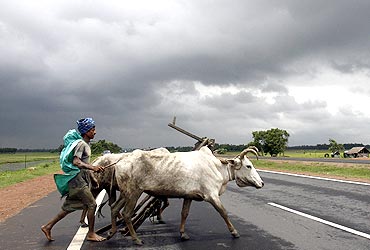
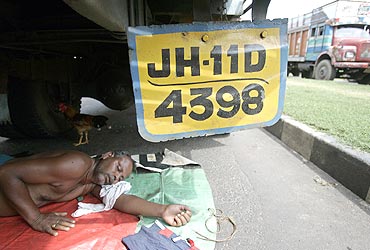
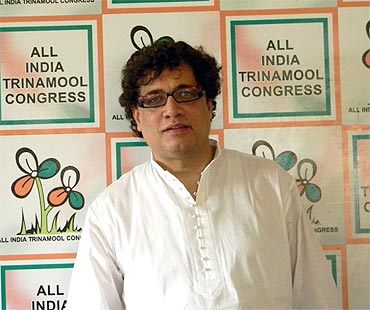
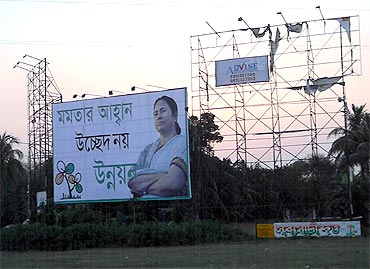
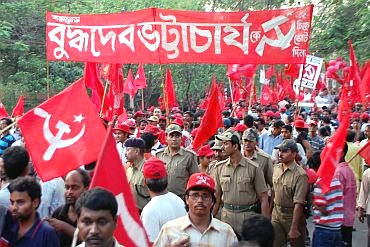

article